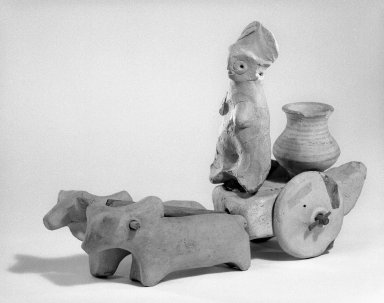
Artist:Indus Valley Culture
Medium: Hand-modeled terracotta
Geograhical Locations:
Dates:ca. 2500 B.C.E.
Dimensions: 1 3/4 x 1 3/16 x 3 9/16 in. (4.5 x 3 x 9 cm)
Collections:
Museum Location: Asian Galleries, Arts of South Asia, 2nd floor
Exhibitions:
Accession Number: 37.97
Image: 37.63_37.92-.94_37.96_37.97_37.106_bw.jpg,
Catalogue Description: Small, summarily-modeled figure of a bullock or humped ox, one of a pair with 37.96, used to draw a toy chariot (37.92 and/or 37.98). These objects are comprised of various components that were found in a disassembled state during an archaeological dig. Their current configuration is not known to be original, and so “components” such as wheels, etc, are labeled with distinct and separate object numbers so that future re-configurations may be possible. Reddish pottery with an uneven surface. The horns are chipped. A hole pierces the animal's neck, to hold the wooden stick (modern) which yokes him to his mate. An almost identical animal from the same site is illustrated in the "Bulletin of the Museum of Fine Arts," Boston, Vol. XXXIV, October 1936, p. 87, figure 11. On page 88, it is stated "Toy vehicles of various shaped made of pottery, mounted on two or four wheels and drawn by a pair of humped oxen as in modern Sind, form an interesting feature of the collection in the Museum." In the account of the Chanhu Daro excavations in "The Illustrated London news" for November 14, 1936, p. 860, Dr. Emert Mackay says "...model casts of pottery in various shapes...together with the little humped oxen that drew them, are exceedingly common--much too many in number to have been only the toys of the children of the little town; they probably supplied the wants of other places, such as Mohenjo-daro, over a wide area."